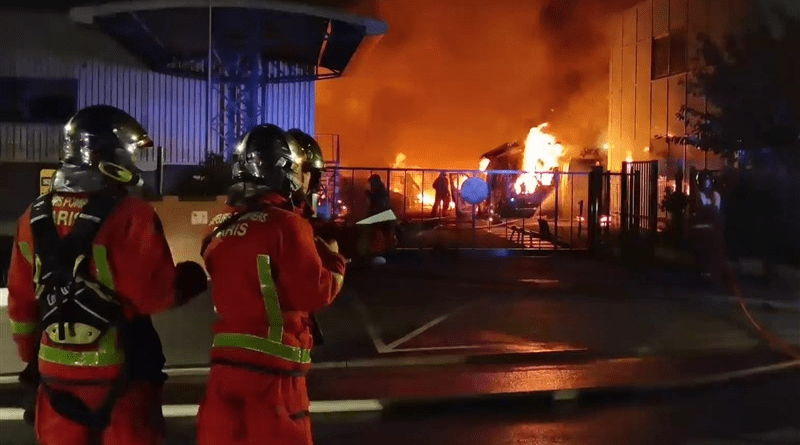French Riots And Social Networks Of Small-Group Dynamics – OpEd
Recent protests in France following the police shooting of a 17-year-old teenager may have opened a complex issue of already deep-seated anguish among refugees and migrants over alleged racism in policing. Nonetheless, according to the grandmother of the teenager killed, other rioters were also using this police shooting “as an excuse” to conduct arson and looting. After hundreds of arrests, reports suggest that the riots were mostly conducted by small-organized groups comprising teenagers and young individuals.
Can we understand the small group dynamics of such social unrest? Can analysis of the groups’ social networks provide answers that could separate what seems obvious from what is veiled under the hood? In short, who are the key players of these networks? If the key players could be identified early, it may be possible for authorities to quell riots early and even prevent them.
Social network analysis here may offer a framework for how small groups organize themselves. Identification of the connections within these networks – their interactions and communication patterns – could shed light on the key players or “hubs” in the network. These hubs are crucial because they are the central agencies that nourish the network and have a major influence on the group’s behavior, their processes and the structures that result out of them. Sometimes an influencer in a network may not be a person who is very visible but someone who is an operative and working undercover. However, by deciphering the communications, friendship linkages, and other ties, these operatives and ideologues could be unearthed.
Today’s encrypted online messaging apps are helping individuals to group around certain shared ideologies, communicate seamlessly and plan an action. A similar incident occurred in 2011 when thousands of people rioted on the streets of London. Also known as ‘London riots’, they started quite in a similar way when a black man was shot by the police. It was found that social media, micro blogging, emails, blogs, and other social media sites enabled 2011 London rioters to communicate freely and organize.
It just takes a click of a button for an influencer to invite his friends in a group or recruit new members. Some of these groups have moved to dark webs where more sensitive actions could be conducted with complete anonymity. In general, those who use these tools rely on their existing channels of communication where one would use to casually communicate, organize sporting, fundraising or outdoor activity or simply hang-out. These same channels are utilized by organizing and committing actions of violent protest, arson and even looting. Part of a small group’s dare to conduct such illegal action again stems from larger group’s (group-of-groups) behavior during large-scale violent protests where there is a sense that law and order are vulnerable.
Predictive policing by law enforcement agencies currently incorporates social media data into policing, where the focus is gradually shifting from reaction to prevention. Social media is a crucial component of big data and a domain of internal security. By analyzing such data quantitatively, it is possible for police to predict and identify targets where riots may occur and prevent such events before they happen.
Rumors also play a key role in igniting passions and carrying messages at a lightning pace. These unverified pieces of information have a strong potential to shape group opinion. Those spreading these rumors may have a desire for social validation. Social structures and cognitive biases play a crucial role in determining the persistence of rumors and shaping rumor dynamics.
To prevent rumors from spreading and curtail the use of social media in general, broadband availability could be restricted in vulnerable regions during such times. Once the situation eases out, they could be gradually resumed.
Small groups are a network where entities (group members) are connected by some kind of relationship (associations or ‘edges’). In a self-centered (or ego-centric) network, an individual of influence may control resources and the flow of communications between his or her immediate edges. Structural holes or the absence of connections within the entities in an ego-centric network could be advantageous, as the central actor is able to control and manipulate this communication as per his or her likes or dislikes. When we draw interconnection of these small networks, what emerges is a sociocentric network, where gatekeepers and highly connected individuals (or hubs) control the overall cohesion and flow of information in the larger network. These networks are often resilient to random attacks but could crumble if a targeted attack is made to influential players in the network.
Law enforcement and other community organizations could design a targeted approach to dismantle these influential players early and nip a problem before it takes bigger and more violent form. In any case, the same approach could still be applied in full blown riot situations.
For the French President, this is one of the worst crises since the 2018 yellow vest protests. However, what remains to be seen is whether the government would do something to get to the root cause of the problem and reach out to these underprivileged and impoverished sections of migrant society who often feel discriminated against. This Algerian descent boy who was shot by police did not have a profile of a criminal. He was the one who was striving hard to fit in French society. He represented the have-not of society, and several migrants could relate themselves to him. When things go wrong, such a group identity is an immensely powerful precursor to the emergence of riots.

